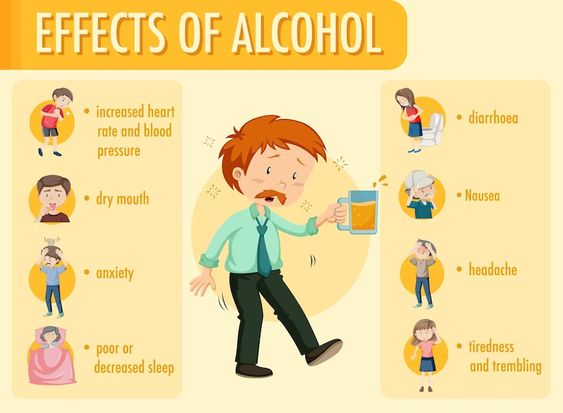NCLEX Exam Questions are an invaluable resource for nursing students striving to master the content required for their licensure exam.
NCLEX Substance Abuse Disorders Questions - NCLEX Questions on Substance Abuse Disorders
Substance Abuse Disorders NCLEX Practice Questions
Question 1.
Maria is a 38-year-old woman who has been admitted to the hospital with symptoms of alcohol withdrawal. She has a history of alcohol abuse and has been drinking heavily for the past few years. On examination, the nurse observes that Maria is experiencing tachycardia, tachypnea, and diaphoresis. The nurse suspects that Maria is going through alcohol withdrawal.
Which of the following statements of the nurse is correct regarding alcohol withdrawal symptoms?
(a) Alcohol withdrawal symptoms begin 24 hours after drinking stops.
(b) Alcohol withdrawal symptoms peak within 24 to 48 hours and decrease within 1 to 2 days.
(c) Alcohol withdrawal symptoms present with marked hand tremors, insomnia, and/or psychomotor agitation.
(d) Delirium tremens (DTs) may appear 12 to 36 hours after the last drink.
Answer:
(b) Alcohol withdrawal symptoms peak within 24 to 48 hours and decrease within 1 to 2 days..
Explanation:
Alcohol withdrawal symptoms typically begin shortly after the person stops drinking, usually within 4 to 6 hours. However, the onset can be delayed in some cases, up to 24 hours. Option (a) is incorrect. Alcohol withdrawal symptoms peak within 48 to 72 hours and then decrease gradually within 4 to 5 days. Symptoms may last longer in some individuals. Option (b) is correct.
The symptoms of alcohol withdrawal may vary from person to person. Some individuals may experience marked hand tremors, insomnia, and/or psychomotor agitation, while others may not. However, tachycardia, tachypnea, and diaphoresis are common symptoms of alcohol withdrawal. Option (c) is incorrect. Delirium tremens (DTs) is a severe form of alcohol withdrawal and may appear 2 to 3 days after the last drink. It is characterized by autonomic hyperactivity, fluctuating levels of consciousness, and hallucinations.
Option (d) is partially correct, but it does not mention that DTs can also appear after 2 to 3 days. Nausea and vomiting may also be present during alcohol withdrawal, but paranoia and hallucinations are not typically associated with alcohol withdrawal unless the client has developed alcohol-induced psychotic disorder.
Option (e) is incorrect. In conclusion, option B is the correct statement regarding alcohol withdrawal symptoms. Alcohol withdrawal can cause various symptoms, including tachycardia, tachypnea, and diaphoresis, and may lead to severe complications such as DTs, grand mal seizures, and death if left untreated.

Question 2.
A 45-year-old patient with a long history of alcohol abuse has been admitted to a hospital for alcohol withdrawal. As a nurse, what nursing intervention should you use?
Which of the following statements about nursing intervention during alcohol withdrawal is correct?
(a) Use direct, matter-of-fact, nonjudgmental attitude.
(b) Confront denial and rationalization (main coping styles used by alcoholics).
(c) Confront manipulations; set finn limits on behavior.
(d) Provide client and family teaching regarding the side effects of disulfiram, acamprosate (Campral), or naltrexone if it is used to promote recovery.
Answer:
(a) Use direct, matter-of-fact, nonjudgmental attitude.
Explanation:
Alcohol withdrawal is a potentially life-threatening condition that requires nursing intervention. The nursing interventions for alcohol withdrawal should focus on keeping the patient safe, comfortable, and calm. The following nursing interventions are appropriate for patients undergoing alcohol withdrawal:
(a) Use direct, matter-of-fact, nonjudgmental attitude: Patients undergoing alcohol withdrawal can be agitated, anxious, and confused. Using a direct, matter-of-fact, and nonjudgmental attitude can help the patient feel safe, comfortable, and respected. It can also help the nurse establish trust with the patient.
(b) Confront denial and rationalization (main coping styles used by alcoholics): Confronting denial and rationalization can cause the patient to become defensive and resistant to treatment. It can also damage the nurse-patient relationship.
(c) Confront manipulations; set firm limits on behavior: While it is important to set limits on behavior during alcohol withdrawal, confrontation can increase anxiety and agitation. It is important to set limits in a calm and nonjudgmental manner.
(d) Provide client and family teaching regarding the side effects of disulfiram, acamprosate (Campral), or naltrexone if it is used to promote recovery: While it is important to provide education about medications, this intervention does not address the immediate needs of the patient undergoing alcohol withdrawal. Therefore, the correct answer is A. Use direct, matter-of-fact, nonjudgmental attitude. This intervention can help the patient feel safe, comfortable, and respected, and can help establish trust between the nurse and patient.
Read More:
